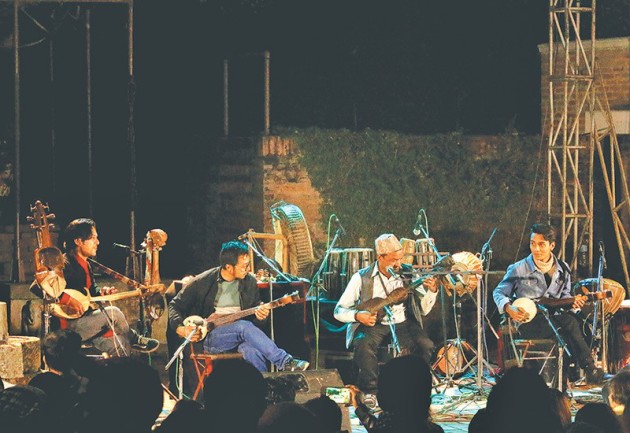The trance of the Tungna
 Sugam Deshar / Kathmandu, April 08: As Bir Bahadur Biswokarma begins strumming the Tungna, anticipation among those who have gathered begins to peak.
Sugam Deshar / Kathmandu, April 08: As Bir Bahadur Biswokarma begins strumming the Tungna, anticipation among those who have gathered begins to peak.
We are sat at the courtyard of the Patan Museum where an album launch for the folk ensemble Kutumba has been transformed into a giant, public busk. As a travelling minstrel (gaine) who makes a living out of busking at bustops and chautaris of towns along the Kodari Highway, Biswokarma is used to the attention the Tungna attracts. But even he has never had an audience this big. Then as he begins to sing “Kangla ko bato” in his uniquely rustic voice, the donations begin to pour in.
Patan has a long history of being generous to its artists, and it doesn’t look like it will disappoint us tonight.
When I found Bir Bahadur Biswokarma on YouTube, under labels like “A blind man singing,” or “A beggar plays the Tungna,” I had reached a dead-end of sorts. As a student of Ethnomusicology—which studies music through cultural and anthropological lenses—I had scoured what little literature is available on the Tungna, but had been left with more questions than answers. Even then, all roads seemed to eventually lead to Biswokarma, who had found small-time fame on the internet through mobile phone videos uploaded by curious travellers, arrested as much by his blindness as his music.
Bir Bahadur Biswokarma is 32, and he has been visually impaired since birth. A resident of Listikot in Sindhupalchowk, near the Kodari border, he picked up the Tungna when he was 16, after deciding that, because it allowed him to sing as he played, it yielded more returns at bus stops than just the flute. As hard as the Tungna is to master, Biswokarma plays it purely by ear; and while he does rely on traditional bhakas and tonal signatures, his penchant for improvisation means that no two songs that he plays is quite the same. Like the long line of traditional minstrels that he belongs to, Biswokarma is no stranger to inducing guffaws for moulding his music according to the crowd that he is playing for, in any of the four languages he can sing in.
The Tungna, Biswokarma’s lute of choice, is a stringed folk instrument, one of the half a dozen ‘guitar-like’ lutes found in Nepal. Played by the Tamang, Sherpa, Hyolmo and other communities, it is a close cousin of other Sino-Tibetan lutes like the Bhutanese Dramyin (Damgyang) and yet unique in its form. Fretless and without a standard scale length, the Tungna, like the 362 different musical instruments in the country, has traditionally been confined to its region, keeping it in a very crude form, making it hard to tune; and harder to master. And like many other folk instruments, the Tungna’s popularity is on the wane, despite it being central to cultural staples like the Tamang Selo.
In 2015, while travelling with an arts initiative to Gatlang, Rasuwa, a scenic, traditional Tamang community, I was surprised to learn that there was just one individual in the large network of villages, that could make the instrument. At a school, when we asked the students to draw the first thing that came to their mind when thinking about music, almost all drew guitars and drums. A few drew madals, even fewer sketched a Tungna.
There are people like Agrim Lama, who makes the instrument in Kathmandu per custom orders; Arun Manandhar of Kutumba; and the Project Tungna which have sought to popularise, preserve and document the instrument in the past years, but the tungna continues to remain an obscure and mysterious instrument, its use limited to large cultural showcases or the handful of travelling minstrels, like Biswokarma.
When Bir Bahadur Biswokarma ends his song with a frenzied crescendo, nearly Rs 30,000 has been collected through the donations. They will go a long way in helping his young family repay debts incurred while rebuilding their house after the 2015 earthquake. His 10-minutes in the limelight at the “City of Fine Arts”, we hope, will bring him further attention in the future.
For many like me, the impromptu set, served as a reminder that even while we sit in the cities and make tall claims and demands about the preservation of folk tunes and instruments, musicians like Biswokarma—who are keeping the traditions alive in their indigenous form—are now more important than ever. Music, after all, is more than just entertainment; it is intricately tied to culture, society, religion, history and local lifestyles. And once an instrument or a musical tradition disappears, a part of our shared heritage and history dies with it.
Which is not to preach a purely ‘nativistic’ approach to music; modern-day fusion ensembles have shown the versatility of folk instruments when paired with western musical styles. But as long as sarangi players continue to be labelled as “pakhe” or “dalit”, things are unlikely to change. In fact, a majority of traditional musicians—the Gandarvas, Damai, Jugi, Badi—are “Dalit”, and while social perception about caste is changing, without concerted effort, it might be too little, too late. But still, if Bir Bahadur Biskwokarma’s entrancing Patan performance is anything to go by, there is hope yet.
– Deshar is a student of ethnomusicology at Kathmandu Universtiy and a member of the folk-fusion band Ma (Source: The Kathmandu Post)
